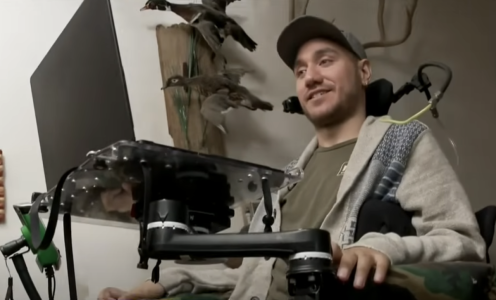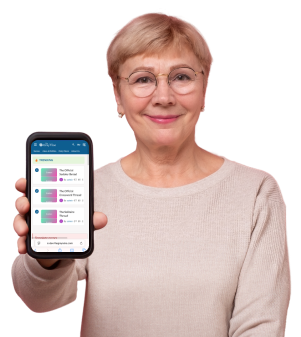The remarkable transformation of a paralyzed man after receiving Elon Musk’s Neuralink implant
By
Veronica E.
- Replies 0
Imagine a world where people can control technology using only their thoughts—a reality once confined to the realm of science fiction.
But today, that future is already unfolding.
For one man, a tiny chip implanted in his brain has reopened doors that once seemed permanently closed.
Thanks to Elon Musk’s Neuralink, he’s experiencing a level of independence that was once unimaginable.
In 2016, a diving accident left Noland paralyzed from the shoulders down, drastically changing his life in an instant.
Everyday tasks, from communication to entertainment, became significant challenges.
But Neuralink’s groundbreaking brain-computer interface (BCI) has given him a way to reconnect with the world—simply by using his mind.

Neuralink’s chip works by detecting and translating brain signals into digital commands.
This allows Noland to operate a computer, move a cursor, and even play video games—all without needing physical movement.
"It sounds so sci-fi," Noland told the BBC, recalling the first time he watched his thoughts translate into action on a screen.
The moment was surreal—seeing his neurons fire as he mentally "moved" his fingers. Over time, he refined his skills and can now play video games well enough to compete with his friends.
But the technology isn't without its challenges.
Early on, Noland experienced a brief disconnection between his implant and the computer, cutting off his ability to interact.
The issue was resolved, but it raised important questions about reliability and dependence on the technology.
While Neuralink represents a major breakthrough, experts warn that brain-computer interfaces come with risks, including privacy concerns.
Could these devices one day access more than just movement-related thoughts?
Scientists continue to debate the ethical and security implications of this kind of technology.
For now, Noland remains optimistic about the future.
He envisions further advancements—perhaps using Neuralink to control a wheelchair or even a robotic assistant.
However, his participation in the study is set for only six years, leaving the long-term impact of the technology uncertain.
At The GrayVine, we understand the importance of independence, especially when facing life-changing circumstances.
Noland’s story isn’t just about cutting-edge technology; it’s about hope, resilience, and the potential of medical advancements to improve lives.
Read next: Another port strike looms as negotiations continue: What’s at stake?

Noland’s journey is a testament to how technology can restore independence and transform lives. But as with any innovation, it also raises important ethical and practical questions. What do you think about Neuralink’s potential? Are you excited about the future of brain-computer interfaces, or do you have concerns?
But today, that future is already unfolding.
For one man, a tiny chip implanted in his brain has reopened doors that once seemed permanently closed.
Thanks to Elon Musk’s Neuralink, he’s experiencing a level of independence that was once unimaginable.
In 2016, a diving accident left Noland paralyzed from the shoulders down, drastically changing his life in an instant.
Everyday tasks, from communication to entertainment, became significant challenges.
But Neuralink’s groundbreaking brain-computer interface (BCI) has given him a way to reconnect with the world—simply by using his mind.

A groundbreaking leap in technology—Noland, the first Neuralink recipient, controls a computer using only his mind. Image Source: YouTube / ABC News.
A Mind-Powered Breakthrough
Neuralink’s chip works by detecting and translating brain signals into digital commands.
This allows Noland to operate a computer, move a cursor, and even play video games—all without needing physical movement.
"It sounds so sci-fi," Noland told the BBC, recalling the first time he watched his thoughts translate into action on a screen.
The moment was surreal—seeing his neurons fire as he mentally "moved" his fingers. Over time, he refined his skills and can now play video games well enough to compete with his friends.
But the technology isn't without its challenges.
Early on, Noland experienced a brief disconnection between his implant and the computer, cutting off his ability to interact.
The issue was resolved, but it raised important questions about reliability and dependence on the technology.
Also read: Elon Musk’s next big move in aviation–What it means for the future of air travel
Innovation, Risks, and the Future
While Neuralink represents a major breakthrough, experts warn that brain-computer interfaces come with risks, including privacy concerns.
Could these devices one day access more than just movement-related thoughts?
Scientists continue to debate the ethical and security implications of this kind of technology.
For now, Noland remains optimistic about the future.
He envisions further advancements—perhaps using Neuralink to control a wheelchair or even a robotic assistant.
However, his participation in the study is set for only six years, leaving the long-term impact of the technology uncertain.
At The GrayVine, we understand the importance of independence, especially when facing life-changing circumstances.
Noland’s story isn’t just about cutting-edge technology; it’s about hope, resilience, and the potential of medical advancements to improve lives.
Read next: Another port strike looms as negotiations continue: What’s at stake?
Key Takeaways
- Noland, a man paralyzed after a diving accident, became the first person to receive a "mind-reading chip" from Neuralink, allowing him to control a computer
using only his mind. - The Neuralink brain-computer interface (BCI) chip translates neural impulses associated with thought into digital commands, enabling Noland to regain a level of independence.
- The technology has allowed Noland to perform tasks such as playing video games using only his thoughts, despite his paralysis.
- While the technology presents exciting possibilities for the future, concerns have been raised about privacy and the potential for one's thoughts and personal information to be externally accessed.
Noland’s journey is a testament to how technology can restore independence and transform lives. But as with any innovation, it also raises important ethical and practical questions. What do you think about Neuralink’s potential? Are you excited about the future of brain-computer interfaces, or do you have concerns?






